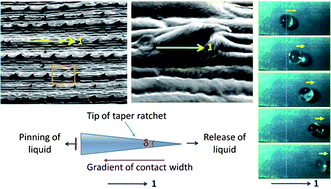Surfaces that control fluids are important in self-cleaning, liquid-transport and cell-directing. They are significantly observed on biological surfaces that control wettability and adhesion by means of micro-/nanostructures, and have aroused interest in foundational and biomimetic research. Here, we report a novel taper-ratchet array on ryegrass leaf. It integrates a gradient of retention at solid–liquid interfaces in contrasting directions to reversibly generate the release or the pinning of solid–liquid contact lines, and accordingly, achieves effective directional water shedding-off properties. By mimicking taper-ratchets from ryegrass leaf, the polymer surfaces are fabricated successfully. They display a robust property of directional water shedding-off. When external vibrations are executed on polymer surfaces, the drops achieve a unidirectional self-shedding along the oriented direction of tips of taper-ratchets, because asymmetric retention forces are formed in the contrasting oriented directions. This investigation will be helpful to design a novel fluid-controlling surface that can be extended to applications such as self-cleaning, liquid-transport and cell-directed projects.

You have access to this article
 Please wait while we load your content...
Something went wrong. Try again?
Please wait while we load your content...
Something went wrong. Try again?


 Please wait while we load your content...
Please wait while we load your content...